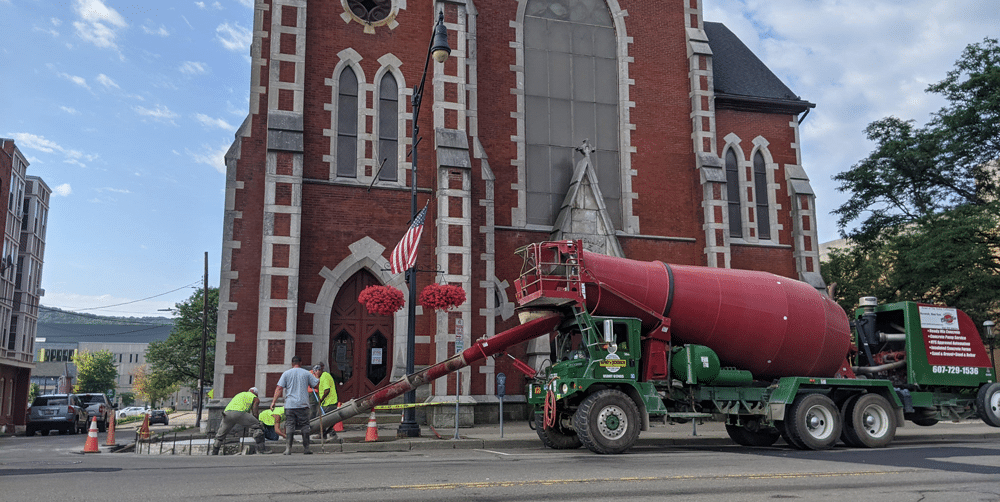To power a climate-conscious economy you need environmentally friendly building blocks.
Materials science is an area of innovation that reimagines the makeup of everyday products used in industries like construction, apparel, and even energy. While the impacts are not yet widely appreciated, advanced materials are poised to have a profound impact on our future and our progress towards sustainability goals.
Advanced materials — built on innovations that can replace or improve conventional materials — are already reducing harmful chemicals and greenhouse gas emissions, enhancing locally sourced supply chains, and cutting down on manufacturing waste.
Empire State Development’s Division of Science, Technology and Innovation (NYSTAR) is at the center of it all. Recent work and collaborations at NYSTAR-backed centers have produced breakthroughs in green building materials, introduced sustainable solutions in fashion, and helped crack the code for reliable and affordable hydrogen-based power.
Greener homes through cleaner concrete
The construction industry continues to search for alternatives to traditional concrete, which is becoming more widely understood as a major contributor to greenhouse gas emissions. Projects at two different NYSTAR-backed centers are helping to produce viable long-term solutions.
The company SQ4D was already an innovator in the industry, specializing in 3D-printed houses and commercial buildings. Then they connected with Alfred University’s Center for Advanced Ceramic Technology (CACT) to test the efficiency and strength of using recycled glass in concrete composition.
The research provided game-changing results.
First, researchers found that incorporating recycled glass cullet into their concrete mix could increase a building’s strength. But more than that, the research — which involved testing different colors of glass — determined that certain colors of glass produced the strongest concrete. The significance? Most colored glasses are the least recyclable and therefore the most likely to end up in a landfill. The new product not only reduces greenhouse gas emissions of the concrete, it also prevents difficult-to-recycle colored glass from ending up in landfills, providing a double environmental benefit.
The proof is in the printing: SQ4D has used this process in demonstration 3D-printed homes on Long Island.
Meanwhile, KLAW Industries received early stage support at Koffman Southern Tier Incubator en route to creating its product, Pantheon™️. Made from glass that otherwise would end up in landfills, Pantheon™️ reacts with cement to add additional crystal structures to the concrete. This allows concrete producers to use 20 percent less cement in their mixes, preventing approximately 1,000 pounds of carbon dioxide emissions per truckload. The City of Binghamton has been investing in its low-carbon future by incorporating Pantheon™️ in the city’s curb and sidewalk upgrades since 2022 with the help of local concrete producer Barney & Dickenson Inc. KLAW Industries, now a thriving business, was recently awarded a $50,000 grant from FuzeHub, the statewide New York Manufacturing Extension Partnership center, to scale its production, and has also received federal recognition, securing the top honor at the Department of Energy’s EPIC Pitch Competition
A sustainable, New York–made wardrobe
New York already boasts the fashion capital of the world, and it’s now stitching together a team of experts at the newly created Fashion Innovation Center to develop a smarter, greener industry.
The consortium of universities, businesses, farmers, fashion industry leaders, and non-profit organizations will be centered in the Capital Region and led by Rensselaer Polytechnic Institute.
In September 2023, NYSTAR selected the consortium members, which include RPI, the Fashion Institute of Technology, Hudson Valley Textile Project, Field to Fiber, SUNY Morrisville, and Made X Hudson.
Their goal: to advance the production of New York State–produced sustainable textiles like hemp, flax and wool, further strengthening collaboration between the state’s strong agricultural sector and the fashion industry.
In addition to research on processing, prototyping, material characterization and testing capabilities, the consortium will also create an accelerator housed within the Fashion Innovation Center to provide space to early stage companies working on promising developments in the field and candidates for commercialization.
Innovating the hydrogen economy
In the future of sustainable energy, hydrogen has emerged as one key to a carbon-free future. However, the current supply of hydrogen poses significant cost, storage and transportation issues.
That’s where Bettergy, a company based in Peekskill, and the NYSTAR-backed Center of Excellence in Materials Informatics at the University at Buffalo come into play.
Together, they are developing a novel catalyst that produced a highly energy-efficient, cost-effective and safe method to use ammonia and convert it to hydrogen. The process allows for the conversation at easier-to-obtain temperatures and reduces the need for precious metals, which address both cost and environmental concerns in hydrogen conversion.
Currently working on commercialization of this critical hydrogen technology and scaling for industrial applications, this ongoing academic-industry partnership has attracted more than $1.5 million in federal funding.
These are just a few examples of NYSTAR and its centers supporting innovations in advanced materials. To learn more about NYSTAR and the resources available to innovators in New York, visit Empire State Development’s website.

